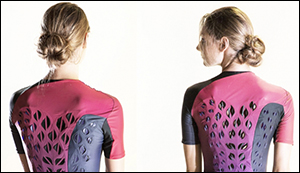Researchers design moisture-responsive workout suit
22. 5. 2017 | MIT | news.mit.edu
A team of MIT researchers has designed a breathable workout suit with ventilating flaps that open and close in response to an athlete’s body heat and sweat.
These flaps, which range from thumbnail- to finger-sized, are lined with live microbial cells that shrink and expand in response to changes in humidity. The cells act as tiny sensors and actuators, driving the flaps to open when an athlete works up a sweat, and pulling them closed when the body has cooled off.

Why use live cells in responsive fabrics? The researchers say that moisture-sensitive cells require no additional elements to sense and respond to humidity. The microbial cells they have used are also proven to be safe to touch and even consume. What’s more, with new genetic engineering tools available today, cells can be prepared quickly and in vast quantities, to express multiple functionalities in addition to moisture response.
The researchers first worked with the most common nonpathogenic strain of E. coli, which was found to swell and shrink in response to changing humidity. They further engineered the cells to express green fluorescent protein, enabling the cell to glow when it senses humid conditions. They then used a cell-printing method they had previously developed to print E. coli onto sheets of rough, natural latex.
Read more at MIT
Image Credit: Hannah Cohen
-jk-



